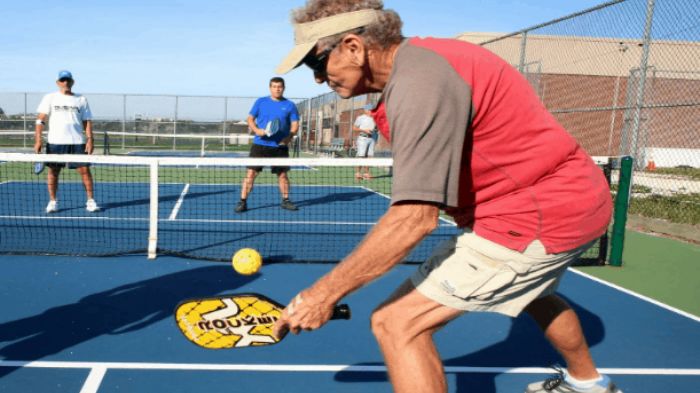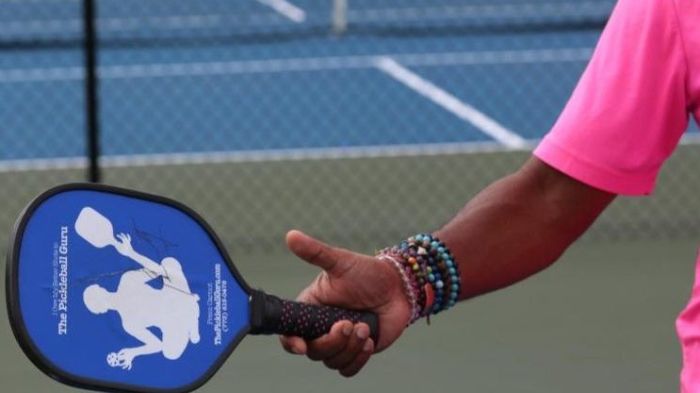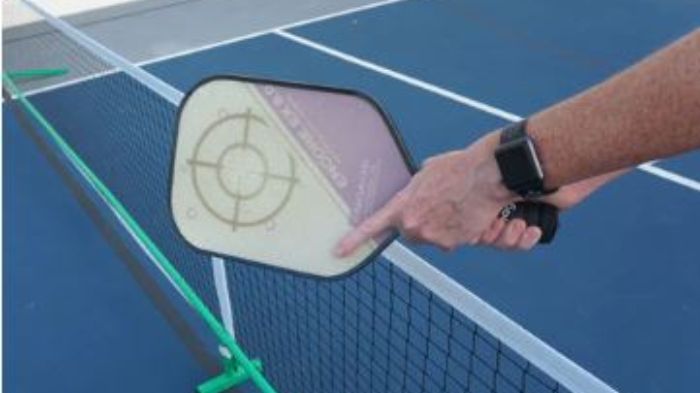The penhold grip is a unique grip style used in pickleball that originated from table tennis. In this grip, the player holds the paddle handle between their thumb and index finger, resembling how one holds a pen or chopstick. The remaining fingers are typically curled up or loosely positioned on the paddle.
The penhold grip offers certain advantages to players. It allows for greater wrist flexibility and agility, providing better control over the paddle and enabling quick adjustments during shots. This grip is particularly effective for executing spin shots, such as topspin and sidespin, as the flexible wrist movement facilitates enhanced spin control. It also allows for deceptive shots and precise ball placements on the court.
However, the penhold grip may not be suitable for everyone. It requires practice and adaptation to develop proficiency, and some players may find it challenging to generate power and stability with this grip, especially on hard-hitting shots. It is important for players to experiment with different grips and find the one that suits their playing style and comfort level and also find out can you play pickleball on concrete?

What Is the Penhold Grip
The penhold grip is a unique grip style used in pickleball that originated from table tennis. In this grip, the player holds the paddle handle between their thumb and index finger, resembling how one holds a pen or chopstick. This grip offers a distinct advantage by allowing for greater wrist flexibility and agility in executing various shots.
When to Use or Avoid the Penhold Grip in Pickleball
Knowing when to use or avoid the penhold grip in pickleball can greatly impact your performance on the court. While the penhold grip offers unique advantages, it may not be suitable for all situations. Here are some considerations to keep in mind:
When to Use the Penhold Grip:
- Spin Shots: The penhold grip excels in generating spin, making it an excellent choice for executing shots with topspin, sidespin, or backspin. The flexible wrist movement allows for enhanced spin control, enabling players to manipulate the ball’s trajectory and placement.
- Deceptive Shots: The penhold grip offers greater wrist flexibility, which can be utilized to create deceptive shots. Players can disguise their shot selection and mislead opponents by changing the paddle angle at the last moment, adding an element of unpredictability to their game.
- Precise Placements: With the penhold grip’s agile wrist movement, players can achieve precise ball placements on the court. This can be particularly advantageous for strategic shots, such as drop shots or shots aimed at the opponent’s weak spots.
When to Avoid the Penhold Grip:
- Power Shots: The penhold grip may not be as effective in generating power on hard-hitting shots. Due to the grip’s finger positioning, it can be challenging to generate the same level of stability and power as other grip styles, such as the Western or Eastern grip.
- Defensive Play: The penhold grip may not offer the same level of stability and reach for defensive shots, such as blocking or counterattacking hard shots. Players may find it harder to absorb the power of the opponent’s shots or execute quick defensive maneuvers.
- Personal Comfort: Ultimately, the choice of grip style depends on personal comfort and preference. Some players may find the penhold grip uncomfortable or less intuitive compared to other grips. It is important to use a grip that allows you to feel confident, comfortable, and in control of your shots.
Pros and Cons of Pickleball Penhold Grip
The penhold grip offers several advantages that make it appealing to certain players. Its wrist flexibility allows for a wider range of shot variations and enhanced control over spin. It can also provide a comfortable grip for those who prefer a more relaxed and natural hand position.
On the other hand, the penhold grip may have limitations. It can require more effort to generate power, and players may need to rely more on technique and placement rather than brute force. It may also take time and practice to master the nuances of this grip and adapt it to different situations during gameplay.
| Pros | Cons |
|---|---|
| Enhanced spin control | Power limitations |
| Shot variation | Defensive challenges |
| Comfortable grip | Technique emphasis |
| Deceptive shots |
Can Penhold Grip Be Used for Both Singles and Doubles Games?
Yes, the penhold grip can be used in both singles and doubles games in pickleball. However, it is important to note that its effectiveness may vary depending on individual playing styles and preferences.

In Singles Games
Where players have more court to cover and rely heavily on individual shot-making, the penhold grip can offer certain advantages. Its wrist flexibility allows for a wider range of shot variations, including spins and angles, giving players the ability to control the placement and direction of the ball with precision.
The grip’s comfortable hold also enables players to maintain a relaxed and natural hand position, which can be beneficial during long rallies and extended play.
In Doubles Games
Where teamwork and coordination are crucial, some players may choose to use the penhold grip to add versatility to their gameplay. The grip’s shot variation capabilities can come in handy when executing deceptive shots or changing the pace of the game.
However, it’s important to consider that the penhold grip may have certain limitations in doubles play. The grip’s power limitations may require players to rely more on technique, placement, and strategic shot selection, rather than relying solely on brute force.
Additionally, defensive challenges may arise due to the grip’s potential impact on stability and reach, especially during quick transitions and net play.
Read About: Pickleball community center And pickleball on wheelchair
How to Use Penhold Grip in Pickleball
- Hand Positioning: Start by securely gripping the handle of the paddle with your thumb and index finger. These two fingers should provide the primary support and control for the grip. The other fingers can rest gently on the paddle for added stability.
- Wrist Flexibility: The penhold grip relies on wrist flexibility to execute a wide range of shot variations. Practice exercises and drills that specifically target wrist movement and flexibility. This can include wrist rotations, flicks, and gentle stretches to enhance your wrist mobility.
- Shot Selection: Experiment with different shot selections to take advantage of the penhold grip’s capabilities. Due to its flexibility, the grip allows for various spins and angles. Practice shots such as topspin, backspin, slices, and angled shots to develop control and precision.
- Seek Guidance: Working with a coach or experienced players can provide valuable guidance and feedback on your technique. They can help you refine your grip, adjust your hand positioning, and offer tips on maximizing the advantages of the penhold grip. Their expertise can assist you in developing proper techniques and improving your overall game.
- Practice Regularly: Like any other aspect of pickleball, using the penhold grip effectively requires practice and repetition. Dedicate time to practice drills that focus on utilizing the penhold grip in different game scenarios. Incorporate the grip into your regular training sessions to build muscle memory and develop confidence in its application.
Difference Between Penhold Grip and Other Grips
Below is a table comparing the continental grip, penhold grip, and eastern grip in pickleball:
| Grip Style | Hand Positioning | Primary Points of Contact | Advantages | Considerations |
|---|---|---|---|---|
| Continental Grip | Index knuckle on upper-right quadrant | Index knuckle and other fingers | Versatile for a wide range of shots | Limited wrist flexibility |
| Penhold Grip | Thumb and index finger as primary contact | Thumb and index finger | Enhanced wrist flexibility and control | May require more practice to master |
| Eastern Grip | Hand positioned further down the handle | Full hand contact | Provides stability for power shots | Limits wrist movement and shot variety |
- A continental grip is a versatile option in pickleball, allowing players to perform a wide range of shots with ease. However, it may limit wrist flexibility compared to the penhold grip and eastern grip.
- The penhold grip offers enhanced wrist flexibility and control, making it ideal for executing spin shots. While it may require more practice to master, it provides players with the ability to add finesse and variation to their game.
- On the other hand, the eastern grip provides a solid grip and stability, which is beneficial for powerful shots. However, it may restrict wrist movement and limit the range of shot options available to players.

Ultimately, the choice of grip in pickleball depends on individual preferences, playing style, and the specific demands of each shot. It is recommended to experiment with different grips, seek guidance from experienced players or coaches, and consistently practice to find the grip that suits your game best.
FAQs
Compared to other popular grip styles like the continental grip and eastern grip, the penhold grip focuses on the thumb and index finger as the primary points of contact. The continental grip involves placing the index knuckle on the upper-right quadrant of the paddle, while the eastern grip positions the hand further down the handle.
While the penhold grip has its advantages, it may require more effort to generate power compared to other grips. Players may need to rely more on technique and shot placement rather than relying solely on brute force. Additionally, it may take time and practice to master the nuances of the penhold grip and adapt it to different situations during gameplay.
Yes, the penhold grip can be utilized in both singles and doubles games. However, its effectiveness may vary depending on individual playing style and preferences. Some players may find it more advantageous in certain situations or game formats, while others may opt for different grips that better suit their needs.
Yes, practicing wrist flexibility and control is crucial to maximize the advantages of the penhold grip. Players can incorporate drills and exercises that specifically target wrist movement and shot variations. Working with a coach or experienced players can also provide valuable guidance and feedback on technique to improve wrist control and overall gameplay with the penhold grip.
Final Words
In conclusion, the penhold grip in pickleball is a unique grip style that involves placing emphasis on the thumb and index finger as the primary points of contact on the paddle handle. This grip offers advantages such as enhanced wrist flexibility, control over spin, and a comfortable hand position.
However, it may require more practice to generate power and master the nuances of this grip. The penhold grip can be used in both singles and doubles games, but its effectiveness may vary depending on individual playing style and preferences. By properly positioning the hand and fingers and incorporating specific drills to improve wrist flexibility and control, players can harness the benefits of the penhold grip and enhance their gameplay.
Ultimately, the choice of grip in pickleball depends on individual preference, playing style, and the specific demands of each shot.



